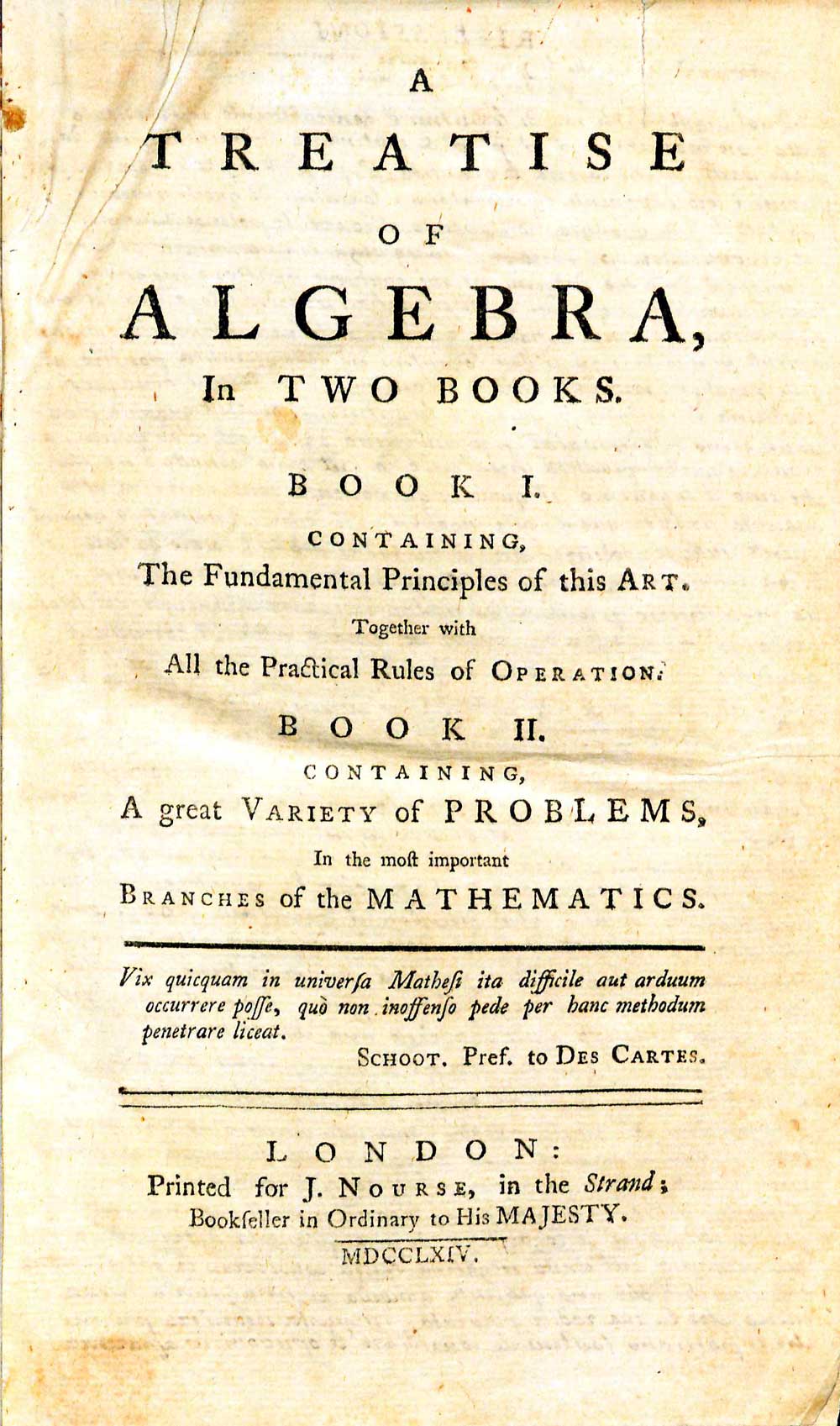A Treatise of Algebra
A Treatise of Algebra: in Two Books
by William Emerson
| A Treatise of Algebra | |
|
Title page from A Treatise of Algebra, George Wythe Collection, Wolf Law Library, College of William & Mary. | |
| Author | William Emerson |
| Published | London: Printed for J. Nourse |
| Date | 1764 |
| Edition | First |
| Language | English |
| Pages | viii, 527 pages, XIII leaves of plates |
| Desc. | 8vo. (21 cm.) |
William Emerson (1701-1782) was a well-known British mathematician in the early eighteenth century. Emerson was the son of a schoolmaster and, after receiving his education, opened a school of his own in 1730.[1] In 1733 his school closed due to lack of interest. It was at that point that Emerson devoted himself entirely to the study of mathematics.[2] In 1743 Emerson published the first of his textbooks, The Doctrine of Fluxions.[3] After it was published, Emerson proceeded to write more textbooks on a wide variety of different mathematical concepts.[4] Many of his published textbooks were bestsellers because they were aimed at all people interested in mathematics rather the narrow niche of researchers or those in the field of academics.[5]
Emerson’s works, including A Treatise on Algebra, were very influential during the eighteenth century and continued to have a lasting effect well into the nineteenth century.[6] Because of the relative simplistic style of A Treatise on Algebra, Emerson was able to effectively communicate mathematical ideas and concepts to a more “common” audience. Prior to Emerson’s work, this broad “common” audience was frequently omitted from consideration when textbooks were published.[7]
Evidence for Inclusion in Wythe's Library
Listed in the Jefferson Inventory of Wythe's Library as Emerson's Algebra. 8vo. This was one of the titles kept by Thomas Jefferson and later sold to the Library of Congress in 1815. George Wythe's Library[8] on LibraryThing indicates "Precise edition unknown. Possible editions were published by Nourse in 1764 and 1780." The Brown Bibliography[9] lists the 1764 edition, based on Millicent Sowerby's entry in Catalogue of the Library of Thomas Jefferson.[10]Jefferson's copy no longer exists to conclusively verify the edition, however, the Wolf Law Library did choose to purchase the edition suggested by Sowerby.
Description of the Wolf Law Library's copy
Backed in contemporary leather with gilt fillets and red label with gilt lettering. Boards speckled.
Find this book in William & Mary's online catalog.
References
- ↑ Alsager Vian, "Emerson, William (1701–1782)", rev. Niccolò Guicciardini in Oxford Dictionary of National Biography (Oxford University Press, 2004- ), accessed 6 Oct 2013. (Subscription required for access.)
- ↑ Ibid.
- ↑ Ibid.
- ↑ Ibid.
- ↑ Ibid.
- ↑ J. O'Conner and E. Robertson, "Emerson biography," in MacTutor History of Mathematics, accessed October 3, 2013 http://www-history.mcs.st-andrews.ac.uk/Biographies/Emerson.html.
- ↑ Vian, "Emerson, William."
- ↑ LibraryThing, s. v. "Member: George Wythe," accessed on November 11, 2013, http://www.librarything.com/profile/GeorgeWythe.
- ↑ Bennie Brown, "The Library of George Wythe of Williamsburg and Richmond," (unpublished manuscript, May, 2012) Microsoft Word file. Earlier edition available at: https://digitalarchive.wm.edu/handle/10288/13433
- ↑ E. Millicent Sowerby, ""Catalogue of the Library of Thomas Jefferson 2nd ed. (Charlottesville: University Press of Virginia, 1983), 4:5 [no.3672].
